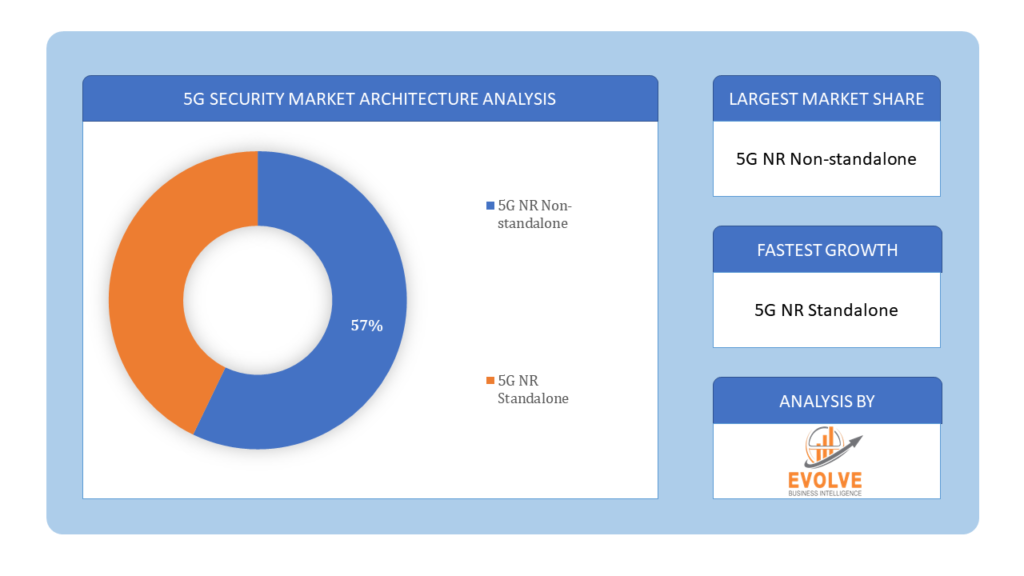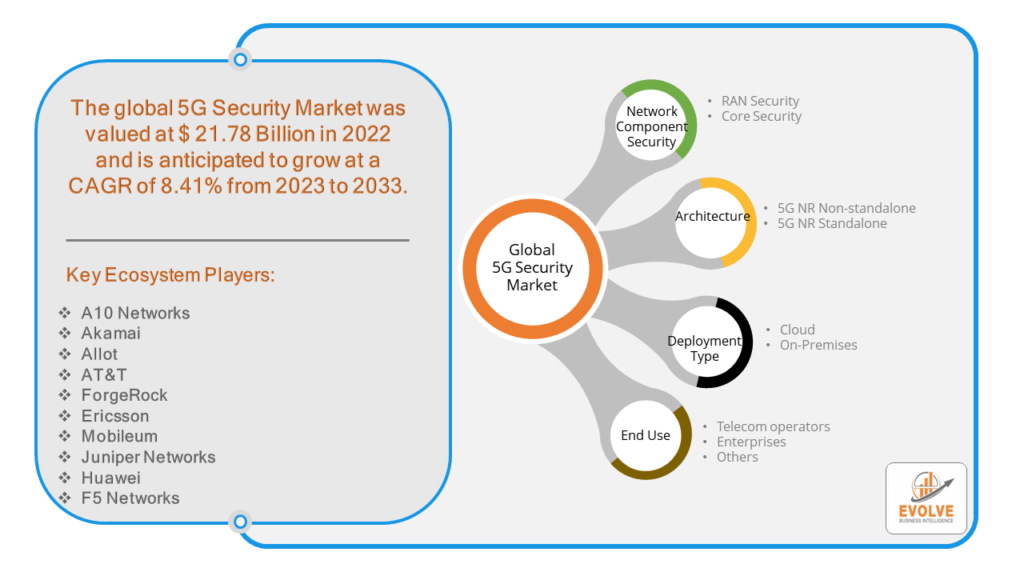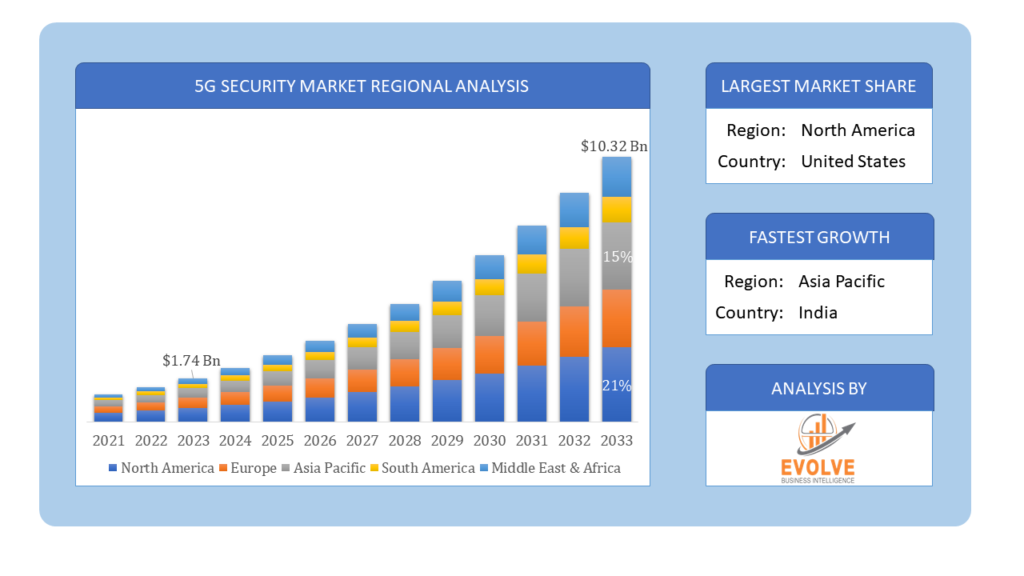5G Security Market Overview
5G Security Market Size is expected to reach USD 10.32 Billion by 2033. The 5G Security industry size accounted for USD 1.74 Billion in 2023 and is expected to expand at a compound annual growth rate (CAGR) of 38.41% from 2023 to 2033. The 5G security market refers to the sector dedicated to safeguarding the infrastructure, networks, and devices involved in 5G communication. It encompasses a range of solutions aimed at protecting against cyber threats, including malware, data breaches, and network intrusions. Key components include encryption technologies, authentication protocols, and intrusion detection systems tailored specifically for the unique challenges posed by 5G networks. With the proliferation of IoT devices and the increasing reliance on ultra-fast connectivity, the demand for robust 5G security measures is escalating, driving growth in this market.
Global 5G Security Market Synopsis
The 5G Security market experienced a detrimental effect due to the Covid-19 pandemic. The COVID-19 pandemic has led to supply chain disruptions leading to supply shortages or lower demand in the 5G security market. The travel restrictions and social-distancing measures have resulted in a sharp drop in consumer and business spending and this pattern is to continue for some time. The end-user trend and preferences have changed due to the pandemic and have resulted in manufacturers, developers, and service providers to adopt various strategies to stabilize the company.
Global 5G Security Market Dynamics
The major factors that have impacted the growth of 5G Security are as follows:
Drivers:
⮚ High-Speed Networks
5G networks offer significantly higher speeds and lower latency compared to previous generations. While this enables innovative applications and services, it also presents new security challenges, such as the need for real-time threat detection and response capabilities.
Restraint:
- Privacy Concerns and Data Sovereignty
5G networks enable the collection and processing of vast amounts of data from connected devices, raising concerns about data privacy, protection, and sovereignty. Compliance with stringent privacy regulations, such as GDPR in Europe, adds complexity to 5G security implementations and may limit the scope of data analytics and monetization initiatives.
Opportunity:
⮚ Development of 5G-specific Security Solutions
There is a growing demand for security solutions tailored specifically for the unique characteristics of 5G networks. This includes solutions that address the challenges of network slicing, edge computing, virtualization, and IoT integration. Companies that can innovate in this space by developing specialized 5G security solutions will have a competitive advantage.
5G Security Market Segment Overview
By Network Component Security
Based on the Network Component Security, the market is segmented based on RAN Security, Core Security. In the 5G security market, Core Security emerges as the dominant segment, offering comprehensive protection for critical network components, ensuring the integrity and confidentiality of data transmission within the core network infrastructure.
By Architecture
 Based on Architecture, the market has been divided into 5G NR Non-standalone, 5G NR Standalone. In the 5G security market, the 5G NR Standalone architecture dominates, offering end-to-end security solutions tailored to the unique challenges of standalone 5G networks, ensuring robust protection against evolving cyber threats.
Based on Architecture, the market has been divided into 5G NR Non-standalone, 5G NR Standalone. In the 5G security market, the 5G NR Standalone architecture dominates, offering end-to-end security solutions tailored to the unique challenges of standalone 5G networks, ensuring robust protection against evolving cyber threats.
By Deployment Type
Based on the Deployment Type, the market has been divided into Cloud, On-Premises.
In the 5G security market, the cloud deployment type dominates due to its scalability, flexibility, and cost-effectiveness, offering seamless integration with evolving network infrastructures.
By End Use
Based on End Use, the market has been divided into Telecom operators, Enterprises, Others. In the 5G security market, telecom operators dominate the segment based on End Uses due to their pivotal role in deploying and managing 5G networks, requiring robust security solutions to safeguard against cyber threats and ensure network integrity.
Global 5G Security Market Regional Analysis
Based on region, the market has been divided into North America, Europe, Asia-Pacific, the Middle East & Africa, and Latin America. The area of North America is anticipated to dominate the market for the usage of 5G Security, followed by those in Asia-Pacific and Europe.
 5G Security North America Market
5G Security North America Market
The North American region holds a dominant position in the 5G Security market. With a projected share of 40.2% in 2022, the North American area is predicted to maintain its leading position and have notable growth at a compound annual growth rate (CAGR) of 40.5% throughout the projection period. Furthermore, some of the leading businesses in the industry that are promoting regional expansion include AT&T, Palo Alto Networks, and A10 Networks, Inc. Growth possibilities for 5G solution providers in the region are presented by manufacturing enterprises’ increasing adoption of 5G security solutions to combat potential threats on 5G networks, helping the North American market’s expansion.
5G Security Asia Pacific Market
The Asia-Pacific region is witnessing rapid growth and emerging as a significant market for the 5G Security industry. Throughout the projection period, the Asia-Pacific region is anticipated to rank second in terms of population. A CAGR of 46.8% is projected for this region’s growth during the predicted period. Telecom companies now have access to a substantial pool of mobile subscribers thanks to the Asia Pacific region’s vast population. The area currently has the largest percentage of mobile users, and in the upcoming years, its subscriber base will grow. This varied region is going through a digital transformation involving many different countries.
Competitive Landscape
The competitive landscape includes key players (tier 1, tier 2, and local) having a presence across the globe. Companies such as A10 Networks, Akamai, Allot, AT&T, and ForgeRock are some of the leading players in the global 5G Security Industry. These players have adopted partnership, acquisition, expansion, and new product development, among others as their key strategies.
Key Market Players:
- A10 Networks
- Akamai
- Allot
- AT&T
- ForgeRock
- Ericsson
- Mobileum
- Juniper Networks
- Huawei
- F5 Networks
Key Development:
February 2023: For businesses wishing to construct private 5G networks and telecom operators looking to enable integrated, automated, and orchestrated security to protect and defend their assets and clients, Atos, a pioneer in managed security services, today announced the launch of its new “5Guard” security offering.
Scope of the Report
Global 5G Security Market, by Network Component Security
- RAN Security
- Core Security
Global 5G Security Market, by Architecture
- 5G NR Non-standalone
- 5G NR Standalone
Global 5G Security Market, by Deployment Type
- Cloud
- On-Premises
Global 5G Security Market, by End Use
- Telecom operators
- Enterprises
- Others
Global 5G Security Market, by Region
- North America
- US
- Canada
- Mexico
- Europe
- UK
- Germany
- France
- Italy
- Spain
- Benelux
- Nordic
- Rest of Europe
- Asia Pacific
- China
- Japan
- South Korea
- Indonesia
- Austalia
- Malaysia
- India
- Rest of Asia Pacific
- South America
- Brazil
- Argentina
- Rest of South America
- Middle East & Africa
- Saudi Arabia
- UAE
- Egypt
- South Africa
- Rest of Middle East & Africa
| Parameters | Indicators |
|---|---|
| Market Size | 2033: $10.32 Billion |
| CAGR | 38.41% CAGR (2023-2033) |
| Base year | 2022 |
| Forecast Period | 2023-2033 |
| Historical Data | 2021 |
| Report Coverage | Revenue Forecast, Competitive Landscape, Growth Factors, and Trends |
| Key Segmentations | Network Component Security, Architecture, Deployment Type, End Use |
| Geographies Covered | North America, Europe, Asia-Pacific, Latin America, Middle East, Africa |
| Key Vendors | A10 Networks, Akamai, Allot, AT&T, ForgeRock, Ericsson, Mobileum, Juniper Networks, Huawei, F5 Networks |
| Key Market Opportunities | Big Data promotes better product designs by utilizing technologies at lower costs and with less hardware |
| Key Market Drivers | Growing ransomware cyber-attacks on IoT devices Increasing attacks on vital infrastructure Rising security concerns in the 5G network |
REPORT CONTENT BRIEF:
- High-level analysis of the current and future 5G Security Industry trends and opportunities
- Detailed analysis of current market drivers, restraining factors, and opportunities analysis in the future
- Historical market size for the year 2021, and forecast from 2023 to 2033
- 5G Security market share analysis for each segment
- Competitor analysis with a comprehensive insight into its product segment, financial strength, and strategies adopted.
- Identifies key strategies adopted by the key players including new product development, mergers and acquisitions, joint ventures, collaborations, and partnerships.
- To identify and understand the various factors involved in the global 5G Security market affected by the pandemic
- To provide year-on-year growth from 2022 to 2033
- To provide short-term, long-term, and overall CAGR comparison from 2022 to 2033.
- Provide Total Addressable Market (TAM) for the Global 5G Security Market.








